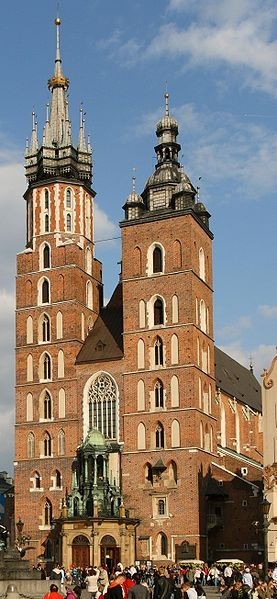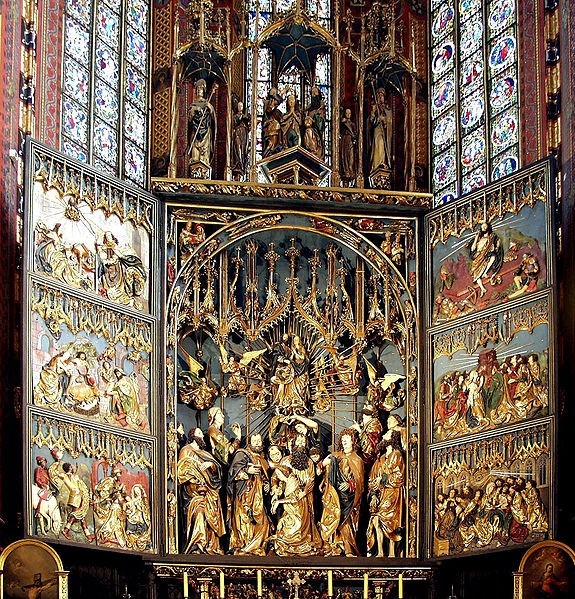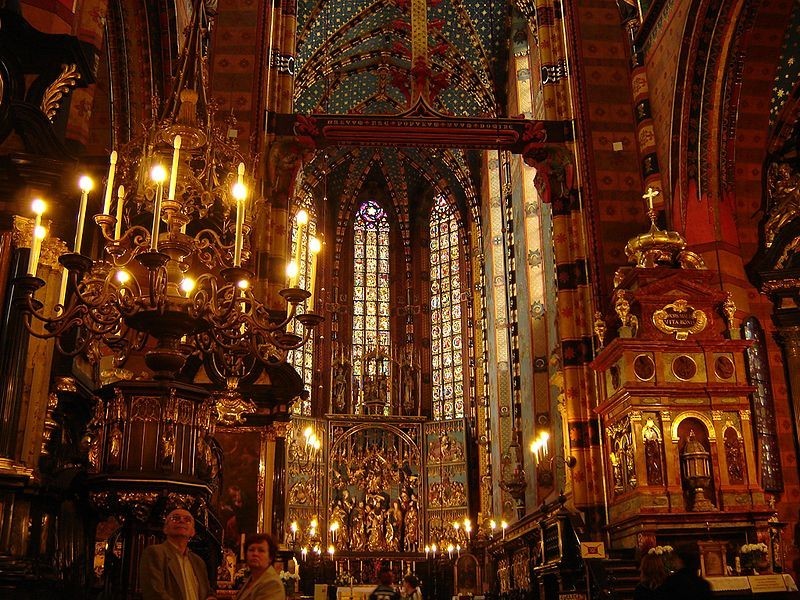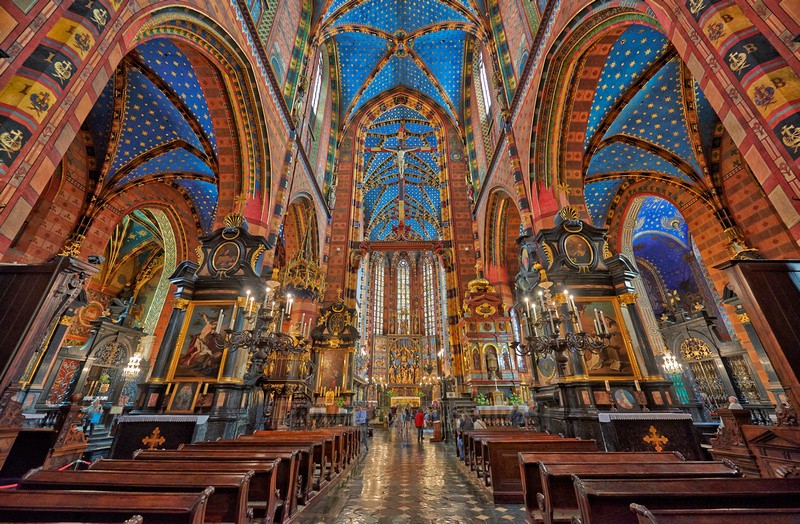

St. Mary Basilica, Krakow, Poland
The altarpiece of Veit Stoss, Oltarz Wita Stwosza, also St. Mary's altar (Oltarz Mariacki), is the largest in the world and a national treasure of Poland. It is located behind the main altar of St. Mary's Basilica. The altarpiece was carved by the German sculptor Veit Stross between 1477 and 1489. The cost, over two thousand gulden, was funded by the citizens of Krakow. The altarpiece is about 42 feet and 3 inches high and 35 feet and 9 inches wide when the panels of the Triptych are completely opened. The realistically sculptured figures are more than 12 ft. high; each one was carved out of a tree trunk of lime tree. Other parts of the altarpiece are made from oak wood, and the background is constructed of larch wood. The scene at the bottom of the altarpiece in the center shows the death of Jesus' mother, Mary, in the presence of the Twelve Apostle. The upper center part illustrates the Assumption of the Madonna.
At the very top, outside the main frame, the coronation of Mary is shown, flanked by figures of St. Stanislaus and St. Adalbert of Prague. The the panels also shows the six scenes of the Joys of Mary: the Annunciation; the Resurrection of Christ; a Nativity Scens; The Ascension of Christ; the Three Wise Men; and the Descent of the Holy Ghost.
At the very top, outside the main frame, the coronation of Mary is shown, flanked by figures of St. Stanislaus and St. Adalbert of Prague. The the panels also shows the six scenes of the Joys of Mary: the Annunciation; the Resurrection of Christ; a Nativity Scens; The Ascension of Christ; the Three Wise Men; and the Descent of the Holy Ghost.

The Gothic Altarpiece of Veit Stoss
Interior of St. Mary Basilica, Krakow, Poland - Note the Ciborium on the Right Side (as you face the photo)

The Pulpit
St. Mary's Basilica, Kosciól Mariacki, is a Brick Catholic Church re-built in the 14th century (originally built in the early 13th century), adjacent to the Main Market Square. Standing 262 ft tall, it is particularly famous for its wooden altarpiece carved by Veit Stoss (Wit Stwosz in Polish). On every hour, a trumpet signal — called the Heinal mariacki — is played from the top of the taller of St. Mary's two towers. The plaintive tune breaks off in mid-stream, to commemorate the famous 13th century trumpeter, who was shot in the throat while sounding the alarm before the Mongol attack on the city. The noon-time hejnal is heard across Poland and abroad broadcast live by the Polish national Radio 1 Station.
St. Mary's Basilica also served as an architectural model for many of the churches that were built by the Polish diaspora abroad, particularly those like St. Michael's in Chicago, St. John Cantius in Chicago, both of which are designed in the so-called Polish Cathedral style. Father Marion Paskowicz, one of St. Mary's pastors in Reading, often maintained that our church was patterned after St. Mary's Basilica in Krakow.
.
The Basilica is familiar to many English-speaking readers from the 1929 book The Trumpeter of Krakow by Eric P. Kelly.
St. Mary's Basilica also served as an architectural model for many of the churches that were built by the Polish diaspora abroad, particularly those like St. Michael's in Chicago, St. John Cantius in Chicago, both of which are designed in the so-called Polish Cathedral style. Father Marion Paskowicz, one of St. Mary's pastors in Reading, often maintained that our church was patterned after St. Mary's Basilica in Krakow.
.
The Basilica is familiar to many English-speaking readers from the 1929 book The Trumpeter of Krakow by Eric P. Kelly.
Veit Stoss, in Polish Wit Stwosz; before 1450 - about 20 September 1533) was a leading German sculptor, mostly in wood, whose career covered the transition between the late Gothic and the Northern Renaissance. His style emphasized pathos and emotion, helped by his virtuoso carving of billowing drapery; it has been called "late Gothic Baroque". He had a large workshop and in addition to his own works there are a number by pupils.
Stoss was born at Horb am Neckar before 1450; his exact date of birth is unknown though it may have been in 1447. Nothing is known certainly of his life before 1473 when he moved to Nuremburg in Franconia and married Barbara Hertz. Their eldest son Andreas was born there before 1477, when Stoss moved to Krakow, the royal capital of Poland, where he was commissioned to produce the enormous polychrome wooden Altar of Veit Stoss at St. Masry's Basilica in Krakow. This was not completed until 1489, and was the largest triptych of its time and, like his other large works, required a large workshop including specialized painters and gilders. Other important works from his period in Poland were the tomb of Casimir IV of Poland in Wawel Cathedral; the marble tomb of Zbigniew Olesnicki in Gniezno; and the altar of St. Stanislaus. The Polish court was more aware of Italian styles than Nuremberg patrons of that period, and some of his Polish work uses Renaissance classical ornament.
In 1496, he returned to Nuremberg with his wife and eight children. He reacquired his citizenship for three gulden and spent the rest of his life sculpting altars,altarpieces, and saint's statues in German territory with occasional forays into Italy. Veit Stoss is buried at St. Johannis cemetery in Nuremberg. His artistic legacy was continued by his son Stanislaw.
Stoss was born at Horb am Neckar before 1450; his exact date of birth is unknown though it may have been in 1447. Nothing is known certainly of his life before 1473 when he moved to Nuremburg in Franconia and married Barbara Hertz. Their eldest son Andreas was born there before 1477, when Stoss moved to Krakow, the royal capital of Poland, where he was commissioned to produce the enormous polychrome wooden Altar of Veit Stoss at St. Masry's Basilica in Krakow. This was not completed until 1489, and was the largest triptych of its time and, like his other large works, required a large workshop including specialized painters and gilders. Other important works from his period in Poland were the tomb of Casimir IV of Poland in Wawel Cathedral; the marble tomb of Zbigniew Olesnicki in Gniezno; and the altar of St. Stanislaus. The Polish court was more aware of Italian styles than Nuremberg patrons of that period, and some of his Polish work uses Renaissance classical ornament.
In 1496, he returned to Nuremberg with his wife and eight children. He reacquired his citizenship for three gulden and spent the rest of his life sculpting altars,altarpieces, and saint's statues in German territory with occasional forays into Italy. Veit Stoss is buried at St. Johannis cemetery in Nuremberg. His artistic legacy was continued by his son Stanislaw.
To view detailed photos of each of the side panels and the centerpiece, click here.



